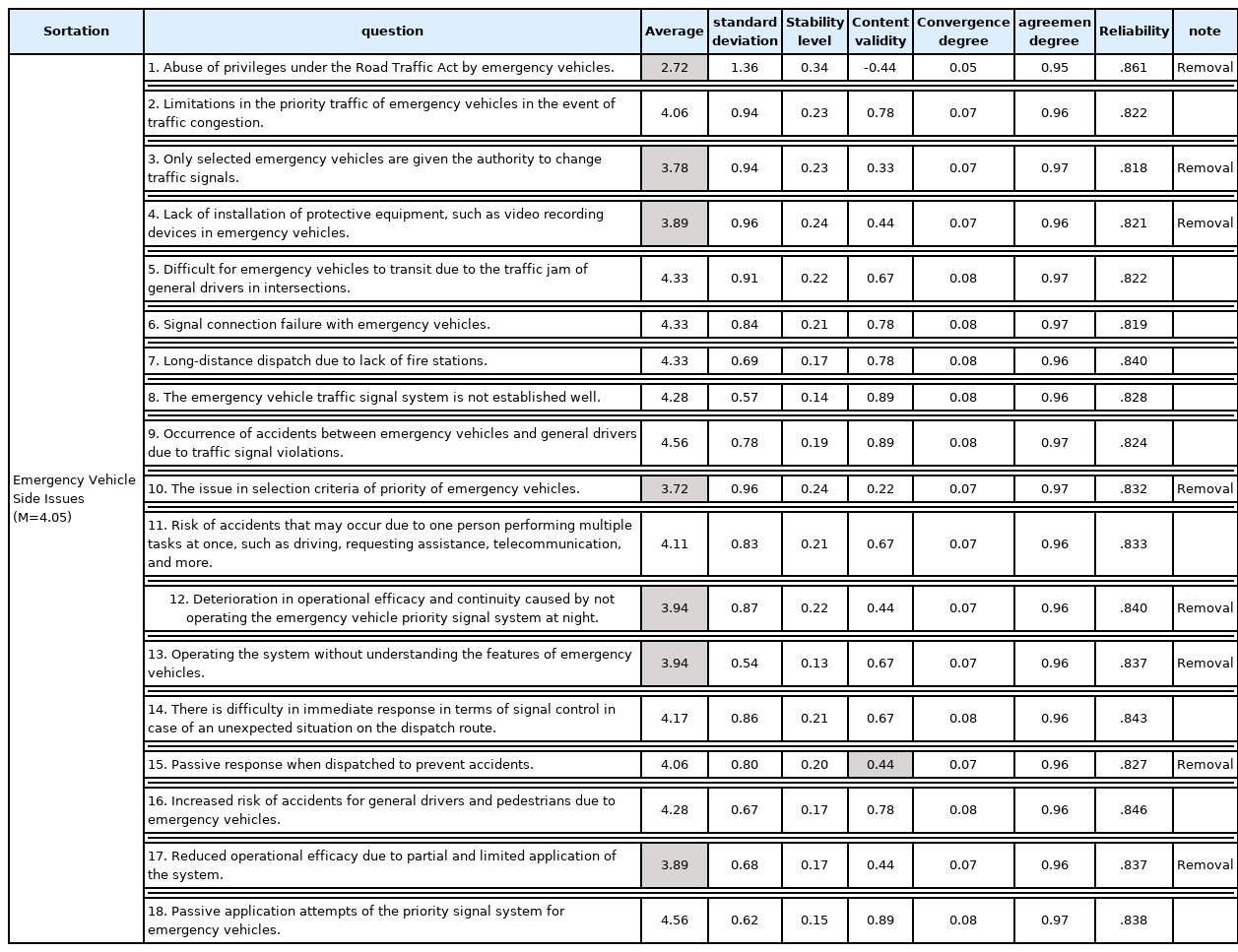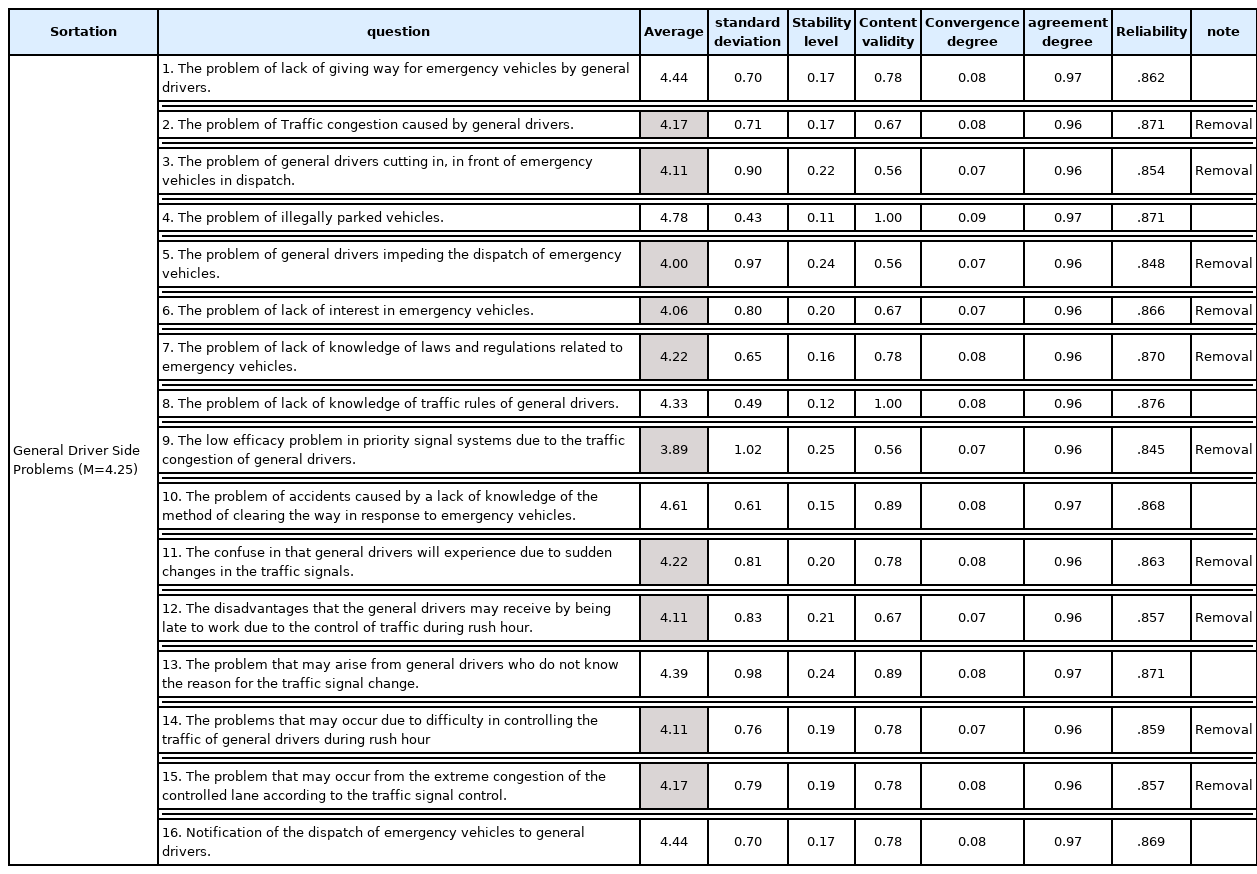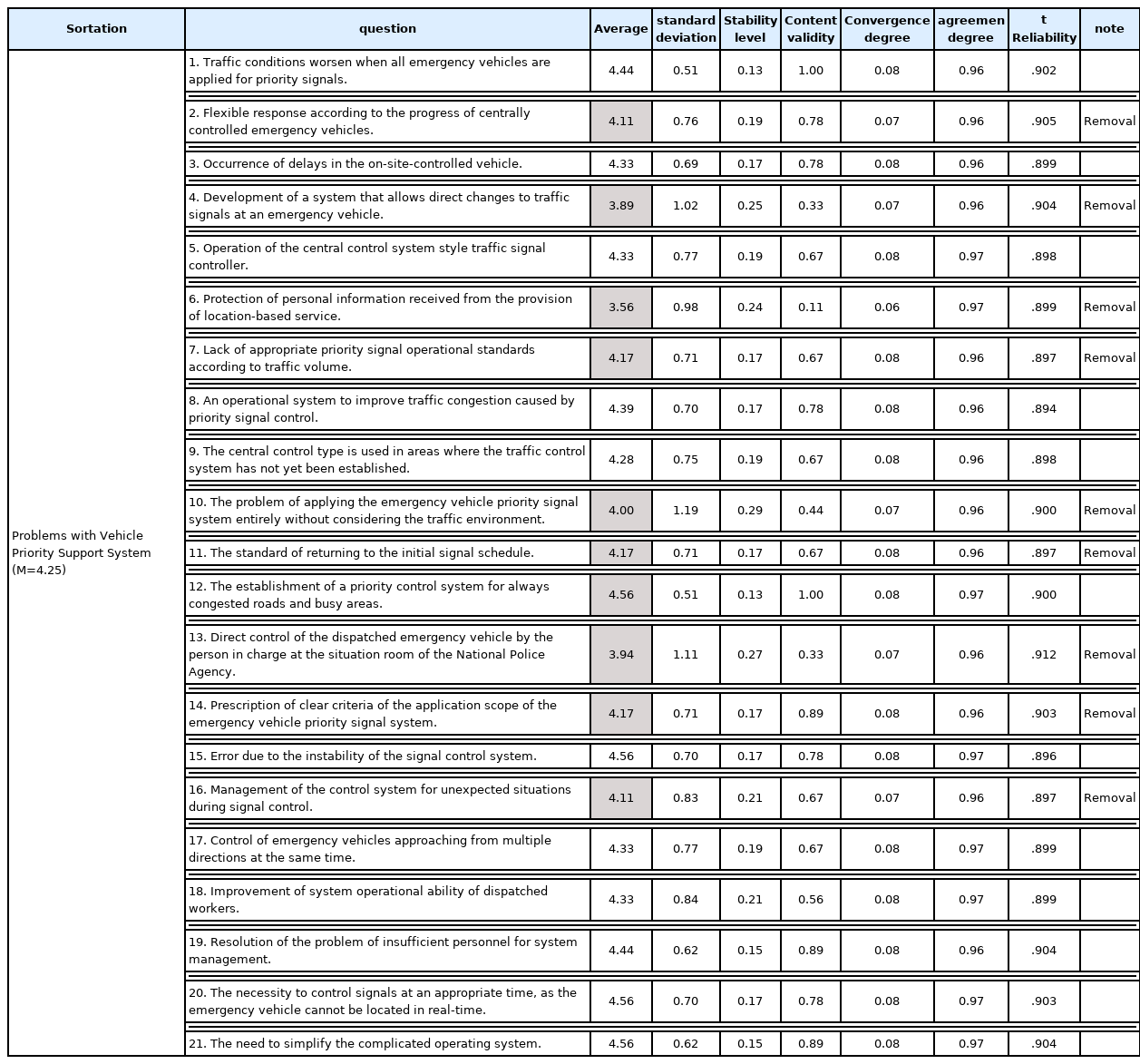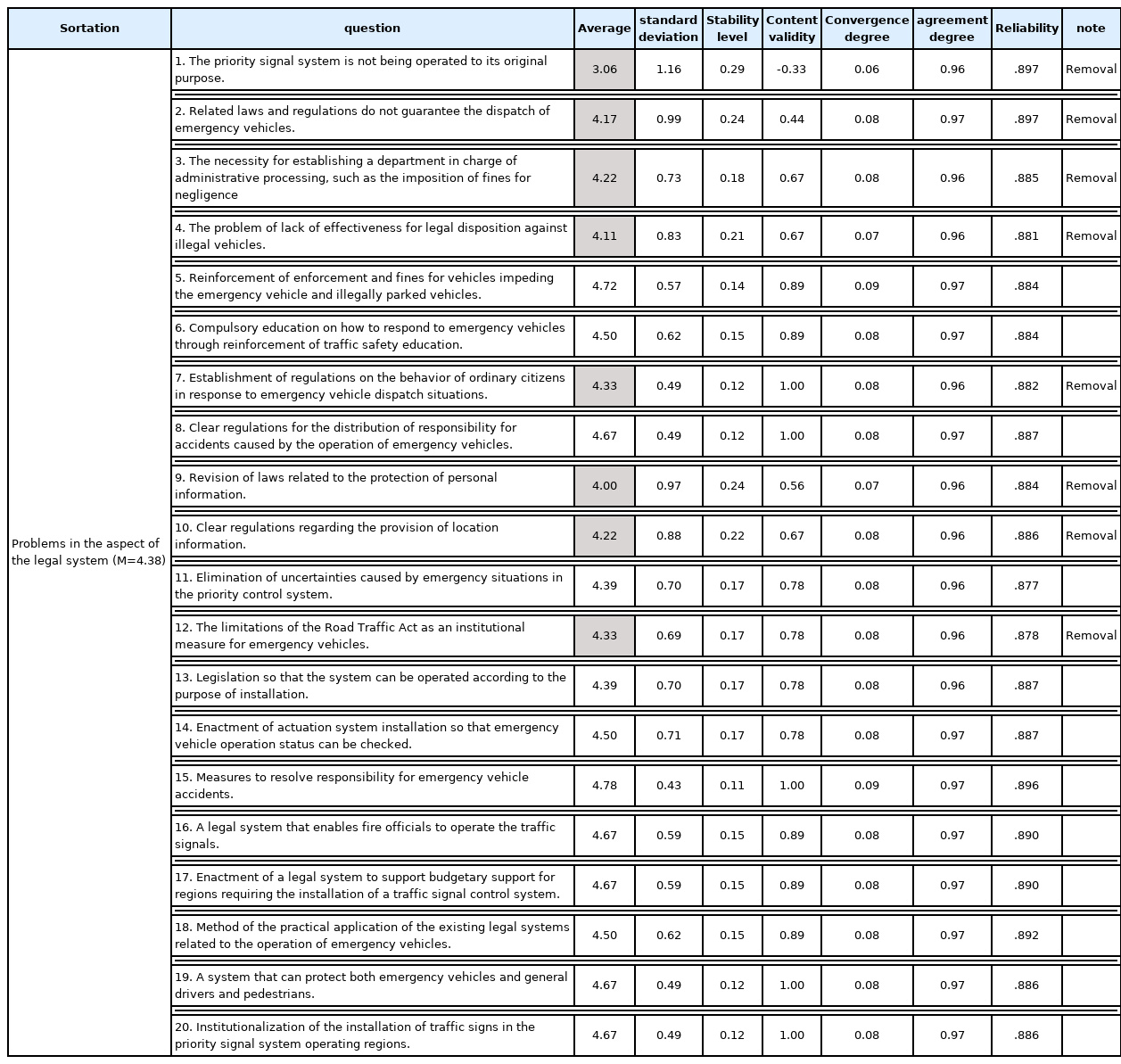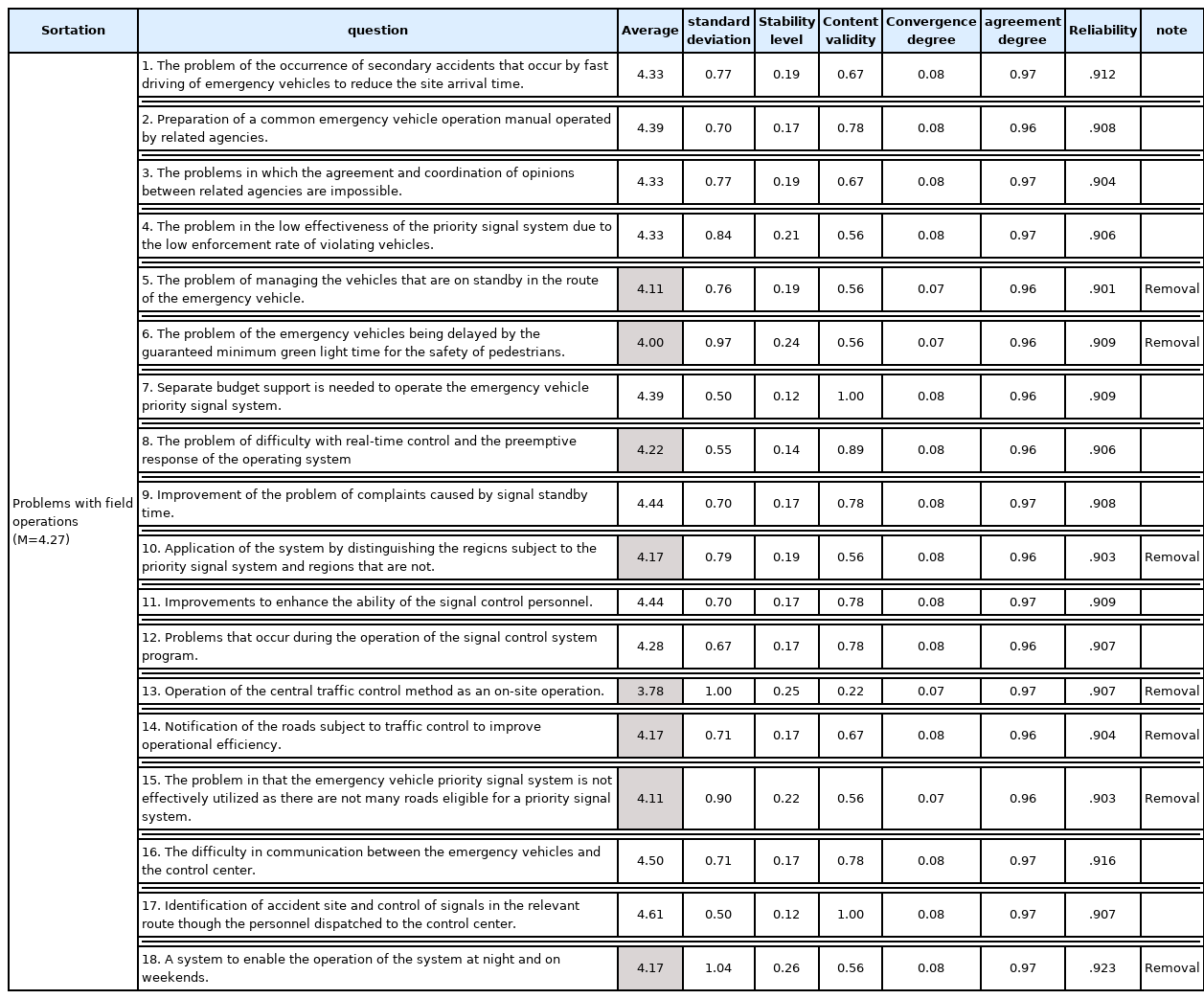긴급차량 우선신호시스템 운영상의 문제점 도출과 개선방안에 관한 델파이 연구
Delphi studies on the operational problems of the Emergency Vehicle Priority Signal System and improvement measures
Article information
Trans Abstract
Purpose:
Prompt arrival of emergency vehicles at the scene is important. Therefore, special cases for emergency vehicles are being applied. However, there remain obstacles that obstruct the prompt arrival during dispatch.
Methods:
First, a literature review revealed five categories of problems with the emergency vehicle priority signal system. Then, the first Delphi survey was conducted to confirm the validity of the five categories. Further, a second Delphi survey was conducted to identify additional problems, and we used a 5-point Likert scale for a third Delphi survey.
Results:
A total of 92 items were extracted from preceding studies. The validity of the five categories was confirmed in the first Delphi survey. Then, 123 additional items were derived from the second Delphi survey, and the final 50 items were selected from 93 items obtained from the third Delphi survey.
Conclusion:
This study revealed problems and improvement measures for improving the operation of the emergency vehicle priority signal system that were not proposed in previous studies.
I. 서 론
1. 연구의 필요성
「도로교통법」에 의하면 “긴급자동차”란 소방차, 구급차, 혈액 공급차량, 그 밖에 대통령령으로 정하는 자동차로서 그 본래의 긴급한 용도로 사용되고 있는 자동차를 말한다. 긴급차량은 용도의 특성상 신속한 현장도착이 중요하며 원활한 임무수행을 위해 「도로교통법」 제30조(긴급자동차에 대한 특례)에서는 자동차 등의 속도제한, 앞지르기 금지, 끼어들기 금지, 신호위반, 중앙선 침범 등 12가지 항목에 대해서 미적용의 특례를 적용하고 있다. 하지만 넘쳐나는 도로위의 자동차는 이러한 특례 조차도 무색하게 만들고 있어 이에 대한 대안으로 ‘긴급차량 우선신호시스템(EVPS)’이라는 교통흐름 제어 체계를 고안하여 소방차나 경찰차 등의 긴급차량이 신호로 의한 지체 없이 목적지까지 도착할 수 있도록 돕고 있다. 시스템 도입으로 출동시간이 감소하는 것으로 나타났다. 황지환 외[1]는 소방차량의 골든타임 한계를 보완하고 현장대응능력을 제고시키기 위해 긴급차량 우선신호시스템 도입 확대의 필요성을 강조하였다. 우선신호란 교차로 신호 현시체계의 일시적 제어를 통해 대중교통 또는 소방차, 구급차 등 긴급자동차와 같은 특정 차량이 교차로를 우선 통과할 수 있도록 우선권을 부여하는 신호운영으로 국내에서는 ‘우선신호’라는 용어를 적용한다[2]. 이준[3]의 연구에 의하면 청주시를 대상으로 실시한 시뮬레이션 분석 연구에서 PLSP(긴급차량 우선신호와 우선차로) 도입 시 긴급차량의 이동속도는 도입 전에 비해 약 3분가량이 단축되어 기존 대비 69%에 이르는 개선 효과가 있음을 밝혔다. 김상연[4]의 연구에서는 긴급차량 통행시간이 최대 350%에서 최소 24%까지 감소하는 것을 확인하였다. 하지만, 여전히 사고현장에 도착하기까지 극심한 교통정체와 긴급차 앞으로 끼어드는 차량, 긴급차 길터주기에 비협조적인 차량 등 여러 장애요인들은 심각한 상태이며[5], 또한 구급차와 소방차 등의 긴급자동차가 임무수행 중 교통사고를 일으킬 경우 긴급차량 운전자가 사고에 대한 책임을 지는 문제점에 대해서도 지적 하였으며[6], 복잡한 우리나라의 교통상황과 긴급출동과 관련된 문제에 큰 관심이 없는 일반인들의 인식과 처신에 대해서도 문제점을 지적하고 있다[7]. 이와 같은 이유 등으로 도로의 교통정체 상황에서 우선신호제어 방식의 효과는 급감하고 있다[3]. 따라서, 운영 시스템상 보완해야 할 부분들이 여전히 존재하고 있으며 이를 해결하기 위한 연구가 필요하다.
하지만 지금까지 긴급자동차 우선신호시스템에 대한 연구는 대부분 긴급차량의 우선차로 및 우선신호 도입효과분석에 관한 연구[2-4], 긴급자동차 우선신호시스템이 가지고 있는 문제점을 분석하고 현장에 적용하기 위한 연구[8, 9], 긴급차량 우선신호시스템 개발과 관련한 연구[10-12]가 주로 이루어져 왔다. 비록 긴급자동차 우선신호시스템의 문제점을 분석하고 효과를 강화하기 위한 연구는 다수 이루어졌지만 긴급자동차 우선신호시스템 도입과 운영에 대한 문제점을 도출하여 범주를 구성한 후 개선방안을 제시한 연구는 거의 이루어지지 않았다.
따라서 본 연구에서는 긴급차량 우선시스템의 운영상 문제점을 개선하기 위해 관련 선행연구 분석을 실시하였다. 더불어 긴급출동 담당업무 전문가의 의견을 통해 긴급자동차 우선신호시스템이 가지고 있는 문제점을 분석하고자 델파이 기법을 활용하였다. 델파이 기법은 전문가의 의견을 수렴하고 이를 객관적으로 결과를 도출한다는 점에서 본 연구에 적합한 방법론이라고 판단하였다.
본 연구 목적을 위한 절차는 다음과 같다. 첫째, 긴급차량 우선신호시스템 문제점을 도출하기 위해 연구주제와 관련한 문헌고찰을 실시하고 다양한 문제점을 추출하였다. 그리고 문제점을 5가지(긴급차량, 일반운전자 측면, 차량우선시스템 측면, 법제도 등 지원측면, 현장운영 측면)로 구분하였다. 이후 델파이 기법을 통해 연구를 진행하기 위해 우선신호시스템과 관련한 분야에서 실무 경험과 전문적인 지식을 겸비한 18명의 전문가를 중심으로 패널을 구성하였다. 둘째, 본 연구에서 구분하고자 하는 범주에 대한 타당성을 확인하기 위해 1차 델파이 조사를 실시하였다. 셋째, 선행연구에서 도출된 문제점 이외의 항목을 확인하기 위해 개방형 설문지를 구성한 후 델파이 2차 조사를 실시하였다. 넷째, 선행연구와 델파이 2차 의견을 통합하여 폐쇄형 설문지를 구성한 3차 델파이 조사를 진행하였고 회수한 설문지는 Excel 2020을 활용하여 평균, 표준편차 타당도, 안정도, 수렴도, 신뢰도 분석을 실시한 후 긴급차량 우선신호시스템 운영상의 문제점을 최종 확정하였다.
본 연구 결과는 향후 우선신호시스템의 전국적 확대 및 보급을 통해 긴급자동차의 골든타임을 사수하여 국민의 생명과 신체·재산을 보호하는데 기여할 수 있는 정보를 제공할 수 있을 것으로 사료된다.
II. 연구방법
1. 연구설계
본 연구는 긴급자동차 우선신호시스템의 문제점을 분석하고 개선방안 제시를 위해 긴급자동차 우선신호시스템 관련 문헌과 선행연구를 고찰하고, 전문가들의 의견을 체계적으로 분석하기 위해 델파이기법(Delphi Method)을 이용한 연구이다.
2. 연구대상
본 연구는 2022년 7월 10일부터 2022년 8월 5일까지 C 소방본부 소속 직원 중 긴급자동차 우선신호시스템 관제나 출동 경험이 있는 직원을 대상으로 하였다. 델파이 기법에서는 전문가들의 의견을 통계적인 방법을 활용하여 항목을 선정하고 평가하므로 전문가 패널 선정이 무엇보다 중요하므로 다음의 세 가지 기준으로 선정하였다. 첫째, 전문성 확보를 위하여 긴급자동차 우선신호시스템과 관련한 분야에서 실무 경험과 전문적인 지식을 겸비한 사람 중 담당업무별 대표성을 가지고 있는 전문가로 구성하였다. 둘째, 보편성 확보를 위해서 본 연구의 패널로 선정된 전문가는 긴급자동차 우선신호시스템의 관제 경험이 있거나 현장 출동업무를 담당하고 있는 실무경험자로 구성하였다. 셋째, 델파이 기법에 대한 연구는 전문가 집단의 합의된 의견으로 이루어지는 것이고, 전문적이고 포괄적인 의견 제공과 성실한 답변과 지속적인 피드백을 공유해야 하므로 설문조사에 참여 의지가 있는 패널을 선정하였다. 이러한 원칙을 전문가 패널 구성에 적용하여 총 18명의 패널을 선정하였으며 패널의 특성은 <Table 1>과 같다.
3. 자료수집 방법
C 소방본부 소속 관련 업무 담당자를 대상으로 델파이 조사를 위한 자료수집은 총 4단계로 진행하였다. 1단계는 문헌조사 및 선행연구를 통해 긴급차량 우선신호시스템 운영에서의 문제점을 추출하였고 추출한 항목들을 긴급차량측면, 일반운전자측면, 차량우선시스템측면, 법제도 등 지원측면, 운영측면의 다섯 가지 유형으로 범주화했다. 2단계는 1차 델파이 조사로 범주화한 5가지 측면의 요인에 대한 타당도 조사를 통해 최종 5가지 요인으로 확정하는 단계이다. 3단계는 2차 델파이 조사단계이다. 2차 델파이 조사는 5가지 요인에 대해 선행연구 이외의 추가요소를 발굴하기 위해 개방형 설문조사를 실시하였다. 4단계는 3차 델파이 조사이다. 3단계 델파이 조사를 위해서 1단계의 선행연구에서 도출된 항목과 2차 델파이 조사에서 추가로 확인된 항목 중에서 중복된 것을 제외하고 최종 항목을 확정하였다. 3단계 델파이 조사는 구조화된 리커트(Likert) 5점 척도를 사용하여 조사를 실시하였다. 그리고 조사결과를 분석하여 최종문항을 선정하였다.
4. 연구도구
본 연구는 긴급자동차 우선신호시스템과 관련한 문헌과 선행연구를 면밀히 고찰하고, 전문가들의 의견을 체계적으로 분석하기 위해 델파이 기법(Delphi Method)을 활용하였다. 델파이 기법은 전문가들의 경험적 지식을 아직 확정되지 않은 문제 해결 및 미래 예측 등에 사용하는 기법의 하나로 본 연구에서는 긴급자동차 우선신호시스템 운영의 문제점을 도출하는데 델파이 기법이 적합하다고 판단하였다.
5. 분석방법
대상자의 일반적 특성은 빈도와 백분율을 이용하였고, 델파이 조사에 대한 분석을 위해 Excel 2020과 IBM SPSS ver. 26을 이용하여 평균, 안정도, 내용타당도, 타당도, 신뢰도를 확인하였다.
III. 연구결과
1. 선행연구 문헌조사를 통한 항목 도출
긴급자동차 우선신호시스템 관련 문제점 확인을 위해 학위논문, 학술지 등을 살펴보았다. 그 결과 92가지 항목을 확인할 수 있었고 이를 긴급차량측면, 일반운전자측면, 차량우선시스템측면, 법제도 등 지원측면, 운영측면으로 분류하였으며, 세부 추출 항목은 긴급차량측면 20개, 일반운전자측면 14개, 차량우선시스템측면 24개, 법제도 등 지원측면 24개, 운영측면 10개로 모두 92개로 확인되었다.
2. 1차 델파이 조사 결과
선행연구를 통해 추출한 항목을 5가지 요인으로 구분하여 분류한 후 분류한 요인이 적합한지를 판단하기 위해 델파이 1차 조사를 실시하였다. 델파이 1차 조사는 긴급차량 우선신호시스템의 운영의 문제점에 대한 핵심요인으로 얼마나 적합하다고 판단하는지 타당성을 확인하기 위한 조사이다. 5가지 범주인 긴급차량측면, 일반운전자측면, 차량우선시스템측면, 법제도 등 지원측면, 운영측면의 타당성 확인을 위해서 구조화된 리커트(Likert) 5점 척도를 사용하였고, 매우 적합 5점, 적합 4점, 보통 3점, 부적합 2점, 매우 부적합 1점으로 구분하였다. 1차 델파이 조사 결과는 <Table 2>과 같다.
델파이 조사에 대한 분석을 위해서 평균, 안정도, 내용타당도, 타당도, 신뢰도를 확인하였다. 안정도(Stability) 0.5 이하인 경우 안정적이라고 판단한다. 내용타당도(Content Validity)는 패널 수에 따라 최소값을 제시하고 있으며 22명 기준으로 0.40 이상일 경우 내용타당도가 확보되었다고 판단한다. 다음으로 타당도(Validity) 검증에서 수렴도는 0에 가까울수록, 합의도는 1에 가까울수록 적합하다고 판단한다. 마지막으로 신뢰도는 Cronbach’s 알파를 기준으로 0.6 이상이면 신뢰도가 확보되었다고 판단한다[13].
1차 델파이 분석 결과를 살펴보면 평균은 최소 4.18, 최대 4.32점으로 높은 것을 알 수 있다. 그리고 안정도는 최대값이 현장운영측면(0.19)로 모두 0.5 이하임을 알 수 있다. 내용타당도는 최소값이 0.55로 모두 0.40 이상으로 확인되었고, 수렴도는 0.048∼0.049, 합의도는 0.975∼0.976으로 모두 기준에 부합함을 알 수 있었다. 마지막으로 신뢰도는 최소값이 현장운영측면(.899)로 기준치를 충족함을 알 수 있었다. 이를 통해서 본 연구 목적을 위해서 분류한 5가지 측면이 모두 타당함을 확인할 수 있었다.
3. 2차 델파이 조사 결과
2차 델파이 조사는 선행연구에서 도출된 항목이외에 추가 요소를 발굴하기 위함이다. 이를 위해서 선정된 패널을 대상으로 개방형 설문조사를 실시하였다. 그 결과 5가지 항목에 전체 123개의 항목을 추가적으로 확인할 수 있었다.
4. 3차 델파이 조사 결과
3차 델파이 조사는 선행연구에서 추출된 92가지 항목과 2차 개방형 델파이 조사에서 도출된 항목 123가지를 통합하였다. 그리고 중복된 항목을 정제한 결과 긴급차량측면 18개, 일반운전자측면 16개, 차량우선시스템측면 21개, 법제도 등 지원측면 20개, 운영측면 18개로 최종 93가지 항목을 확정할 수 있었으며 5점 리커트 척도를 활용하여 폐쇄형으로 설문을 구성하였다.
1) 긴급차량 측면 문제점
긴급차량 측면에서의 문제점에 대한 델파이 분석 결과는 <Table 3>과 같으며 전체 평균은 4.05점으로 확인되었다. 평균을 기준으로 4.05가 되지 않은 7항목을 제거(문제점1, 문제점3, 문제점 4, 문제점10, 문제점12, 문제점13, 문제점17)하였으며 안정도는 모두 충족한 것으로 확인되었다. 내용타당도에서 0.45가 충족되지 않은 1문항(문제점15)이 제거되었으며 수렴도, 합의도, 신뢰도는 모두 기준치에 적합함을 알 수 있었다. 이를 통해 긴급차량 측면 문제점 18가지 중에서 8항목은 제거가 되었고 10항목이 최종 확정되었다.
2) 일반운전자 측면 문제점
일반운전자 측면에서의 문제점에 대한 델파이 분석 결과는 <Table 4>와 같으며 전체 평균은 4.25점으로 확인되었다. 평균을 기준으로 4.25가 되지 않은 10항목을 제거(문제점2, 문제점3, 문제점 5, 문제점6, 문제점7, 문제점9, 문제점11, 문제점12, 문제점14, 문제점15)하였으며 안정도, 내용타당도,수렴도, 합의도, 신뢰도는 모두 기준치에 적합함을 알 수 있었다. 이를 통해서 긴급차량 측면의 문제점 16가지 중에서 10항목은 제거가 되었고 8항목이 최종 확정되었다.
3) 차량우선지원시스템 측면 문제점
차량우선지원시스템 측면에서의 문제점에 대한 델파이 분석 결과는 <Table 5>와 같으며 전체 평균은 4.25점으로 확인되었다. 평균을 기준으로 4.25가 되지 않은 9항목을 제거(문제점2, 문제점4, 문제점6, 문제점7, 문제점10, 문제점11, 문제점13, 문제점14, 문제점16)하였으며 안정도, 내용타당도, 수렴도, 합의도, 신뢰도는 모두 기준치에 적합함을 알 수 있었다. 이를 통해서 차량우선지원시스템 측면 문제점 21가지 중에서 9항목은 제거가 되었고 12항목이 최종 확정 되었다.
4) 법제도 측면 문제점
법제도 측면에서의 문제점에 대한 델파이 분석 결과는 <Table 6>과 같으며 전체 평균은 4.38점으로 확인되었다. 평균을 기준으로 4.38이 되지 않은 8항목을 제거(문제점1, 문제점2, 문제점3, 문제점4, 문제점7, 문제점9, 문제점10, 문제점12)하였으며 안정도, 내용타당도, 수렴도, 합의도, 신뢰도는 모두 기준치에 적합함을 알 수 있었다. 이를 통해서 법제도 측면 문제점 20가지 중에서 8항목은 제거가 되었고 12항목이 최종 확정 되었다.
5) 현장운영 측면 문제점
현장운영 측면에서의 문제점에 대한 델파이 분석 결과는 <Table 7>와 같으며 전체 평균은 4.27점으로 확인되었다. 평균을 기준으로 4.27이 되지 않은 8항목을 제거(문제점5, 문제점6, 문제점8, 문제점10, 문제점13, 문제점14, 문제점15, 문제점18)하였으며 안정도, 내용타당도, 수렴도, 합의도, 신뢰도는 모두 기준치에 적합함을 알 수 있었다. 이를 통해서 현장운영 측면 문제점 18가지 중에서 8항목은 제거가 되었고 10항목이 최종 확정되었다.
지금까지 델파이 3차 조사 결과를 살펴보았으며 최초 93문항에서 평균 이하 제거(42문항), 타당도 제거(1문항)한 결과 최종 50개 항목(긴급차량 10, 일반운전자6, 차량우선시스템 12, 법제도 12, 운영 10)을 확정하였다. 3차 델파이 조사 최종 확정 결과는 <Table 8>과 같다.
3차 델파이 조사를 분석 요약한 결과는 <Table 9>와 같다.
IV. 고 찰
본 연구의 목적은 긴급자동차 우선신호시스템이 가지고 있는 문제점을 살펴보고 이를 중심으로 우선신호시스템의 문제점을 개선하여 전국적 확대 및 보급을 통해 국민의 생명과 신체·재산을 보호하는데 기여하기 위함이다. 연구목적을 위해 긴급차량 우선신호시스템 관련 선행연구를 고찰하였고 18명의 전문가 패널을 중심으로 델파이 조사를 실시하였다. 델파이 1차 조사는 선행연구에서 도출된 항목에 대하여 범주화 한 5가지 측면에 대한 타당도를 확인하기 위해 실시하였고 델파이 2차 조사에서는 5가지 범주를 중심으로 선행연구 이외에 추가적인 항목을 발굴하고자 하였다. 이후 델파이 3차 조사에서는 리커트(Likert) 5점 척도를 사용하여 최종 문제점을 확정하였고 주요 연구결과는 다음과 같다.
첫째, 긴급차량 우선신호시스템 문제점을 도출하기 위해 연구주제와 관련한 선행연구를 살펴본 결과 92개의 항목을 확인할 수 있었다. 그리고 선행연구 항목을 포괄할 수 있는 범주화를 5가지(긴급차량, 일반운전자, 차량우선시스템, 법제도 등 지원, 현장운영)측면으로 구분하였다. 둘째, 델파이 1차 조사결과 요약이다. 1차 조사는 선행연구를 기반으로 범주화한 핵심 요인 5가지에 대한 타당성을 확인하기 위함이다. 즉, 5가지(긴급차량측면, 일반운전자측면, 차량우선시스템측면, 법제도 등 지원측면, 운영측면)에 대한 내용의 타당성 확인을 위해 폐쇄형 설문을 실시한 결과 평균은 전체적으로 5점 만점에 4.2점 이상 수준으로 양호한 것으로 확인되었다. 그리고 안정도, 내용타당도, 수렴도, 합의도, 신뢰도는 모두 기준치에 적합하여 5가지 범주가 타당한 것으로 확인되었다. 셋째, 델파이 2차 조사 결과이다. 델파이 2차 조사는 5가지(긴급차량, 일반운전자, 차량우선시스템, 법제도 등 지원, 운영)에 대한 선행연구 이외 추가적인 내용을 도출하기 위해 진행이 되었으며 전체 123개의 항목을 확인할 수 있었다. 넷째, 델파이 3차 조사결과이다. 3차 조사에 앞서 5가지 측면에 대해서 선행연구에서 도출된 항목 92개와 2차 개방형 델파이 조사에서 도출된 123개에 대해서 중복되는 항목을 통합 및 정제를 거쳐 최종 93개 항목으로 확정을 하였다. 그리고 93개 항목을 폐쇄형 설문을 구성하여 평균, 안정도, 내용타당도, 수렴도, 합의도, 신뢰도 검증을 통해 전체 50개 항목(긴급차량 10, 일반운전자 6, 차량우선신호시스템 12, 법제도 12, 운영 10)이 최종 확정되었다.
본 연구에서는 긴급차량 우선신호시스템 운영에서 발생하는 문제점을 개선하기 위한 항목을 도출하기 위해 델파이 기법을 활용하였고 그 결과 5가지 측면에서 50개 항목을 최종 확인할 수 있었다. 긴급차량 측면에서 문제점으로 ‘긴급차량이 출동 중 신호위반 등으로 사고가 발생하는 문제’를 개선해야 한다는 항목과 ‘긴급차량의 소극적인 우선신호시스템 사용 시도’의 문제점을 개선해야 한다는 항목이 4.56점으로 가장 높은 점수를 보이는 것으로 확인되었다. 이는 선행연구자 김종갑[9]이 긴급자동차 교통사고는 급박한 현장 상황이라는 특수성 때문에 대형사고로 연결될 수 있으며, 교통사고로 인한 초기 대웅 실패에 따라 인명과 재산의 피해가 확대될 가능성을 내포하고 있다는 내용을 지지하는 결과이다. 이 연구에서 피양의 필요성 홍보와 교육, 교통신호체계 개발에 대한 내용을 강조하였다. 그리고 일반운전자 측면에서는 ‘일반운전자의 불법주정차 문제’가 4.78점으로 가장 심각한 문제로 지적되었다. 이는 선행연구자 성중기[14]의 연구에서 긴급차량 출동이 지연되는 원인으로 골목길 불법주정차와 이정일 외[15]의 ‘5분 이내 대응’이 완벽하게 실현되지는 못하고 있는 첫 번째 출동 장애요인으로 불법 주·정차, 도로 혼잡 등으로 소방 출동로 확보가 곤란하기 때문으로 거론한 것과 맥락을 같이한다. 차량우선지원시스템 측면에서는 ‘상시 정체구간·밀집지역 우선 통제시스템 구축’의 문제점을 개선해야 한다는 의견 등이 항목이 4.56점으로 높게 나타났다. 이는 선행연구자 정기신[5]의 연구에서도 긴급차가 현장에 도착하는데 가장 중요한 요소는 도로상의 문제이며 극심한 교통정체, 비좁은 도로, 불법주정차 문제를 거론한 것에서도 나타났다.
법제도 측면에서는 ‘긴급차량 사고로 인한 책임 소재를 해소하기 위한 방안’ 문제가 4.78점으로 가장 높게 나타났다. 이는 선행연구자 김종갑 외[9]의 연구에서도 긴급차량을 운전하는 운전자의 경제적 불이익과 신분상 불이익이 가지 않도록 보장되어야 하나, 현행법과 제도적인 모순으로 인해 교통사고 발생 민·형사상 불이익뿐만 아니라 행정적 책임, 나아가 징계 등의 조치까지도 이루어지고 있는 실정이라고 거론한 것에서도 나타났다. 현장운영측면에서는 ‘관제센터로 파견된 직원을 통해 사고위치 파악과 노선 통제’ 문제가 4.61점으로 가장 높게 나타났다. 이는 현장의 특성을 잘 이해하고 있는 해당기관의 직원이 직접 노선통제를 하여 최적의 출동로를 선택하여야 하는 필요성을 느끼고 있는 담당자들의 의견이 반영된 것으로 보인다.
V. 결론 및 제언
본 연구에서는 기존 연구에서 제시하지 않았던 긴급차량 우선신호시스템의 운영개선을 위한 주요한 문제점을 도출하였다는 점에서 학문적 시사점을 가진다. 그리고 지금까지 관련 연구에서는 주로 운영시스템의 개선을 위한 시스템적 측면에서 접근을 하였으나 운영전반에 대한 관리적 차원에서 접근했다는 점에서 의미를 가진다고 할 수 있다. 또한 본 연구에서는 긴급차량 측면에서 ‘긴급차량이 출동 중 신호위반 등으로 사고가 발생하는 문제’가 개선이 되어야 함을 확인하였다. 이를 위해서는 일반운전자의 우선신호시스템에 대한 이해와 양보운전과 함께 긴급출동차량의 안전사고예방과 같은 적극적인 시스템 활용을 위해 노력해야할 것이다. 그리고 일반운전자 측면에서 ‘일반운전자의 긴급차량에 대한 양보와 통행방법 인식의 문제’가 개선되어야 함을 확인하였으며 이를 위해 일반인에 대한 긴급차량에 대한 양보와 교육의 확대를 위해 노력해야 할 것이다. 차량우선지원시스템 측면에서는 ‘시스템 적용 시 교통상황이 악화되거나 교통차량 지체가 발생하는 문제’가 개선되어야 함이 확인되었다. 이를 위해 제어시스템의 관리와 개선 등 시스템의 보완을 위해 노력해야 할 것이다. 법제도 측면에서는 ‘진로방해 등 불법차량에 대한 제제, 법제도의 명확한 규정문제’의 개선이 필요함이 확인되었으며 이를 위해 교통안전교육 의무화 및 제도의 마련과 같은 법제도의 실질적인 적용을 위하여 노력하여야 할 것이다. 현장운영 측면에서 ‘긴급자동차의 2차사고 유발과 관계기관들과의 협의의 문제’가 개선되어야 함을 확인하였다. 이를 위해 긴급자동차 운영매뉴얼 마련과 협업에 대한 대안을 제시하고 민원발생의 문제점 등에 대해서 개선이 이루어져야 할 것이다. 이처럼 본 연구에서는 5가지 측면에서 문제점을 확인하고 이를 개선하기 위한 방안을 제시했다는 점에서 실무적 시사점을 가진다고 할 것이다.
이처럼 본 연구는 학문적 실무적 시사점을 가짐에도 불구하고 다음과 같은 한계를 가진다. 본 연구에서는 긴급차량 출동과 관련된 담당자를 중심으로 패널을 구성하였다. 하지만 긴급차량 출동과 관련한 다양한 분야의 전문가를 패널 구성하지 못한 한계를 가진다. 따라서 후속 연구에서는 보다 다양한 패널 구성을 통한 연구가 이루어지길 제안한다.



